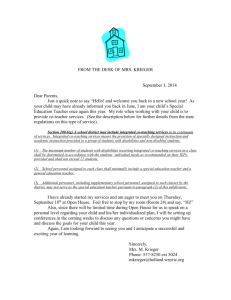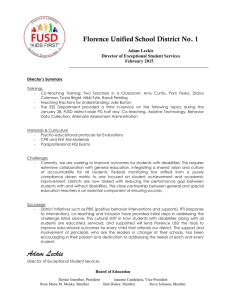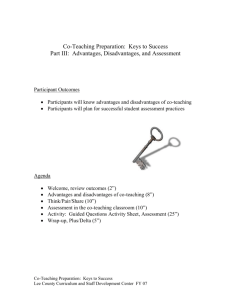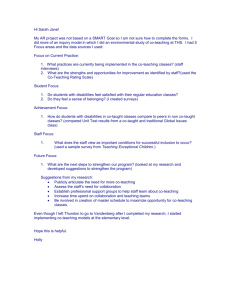Effective Co-teaching: B - GADOE Georgia Department of Education
advertisement
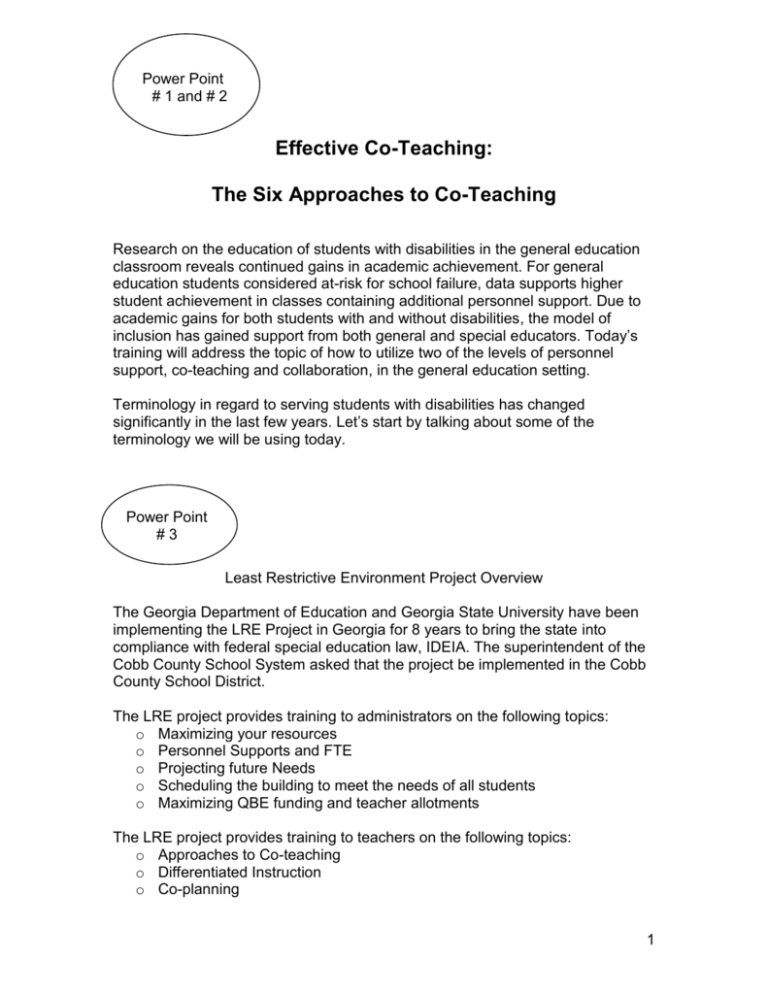
Power Point # 1 and # 2 Effective Co-Teaching: The Six Approaches to Co-Teaching Research on the education of students with disabilities in the general education classroom reveals continued gains in academic achievement. For general education students considered at-risk for school failure, data supports higher student achievement in classes containing additional personnel support. Due to academic gains for both students with and without disabilities, the model of inclusion has gained support from both general and special educators. Today’s training will address the topic of how to utilize two of the levels of personnel support, co-teaching and collaboration, in the general education setting. Terminology in regard to serving students with disabilities has changed significantly in the last few years. Let’s start by talking about some of the terminology we will be using today. Power Point #3 Least Restrictive Environment Project Overview The Georgia Department of Education and Georgia State University have been implementing the LRE Project in Georgia for 8 years to bring the state into compliance with federal special education law, IDEIA. The superintendent of the Cobb County School System asked that the project be implemented in the Cobb County School District. The LRE project provides training to administrators on the following topics: o Maximizing your resources o Personnel Supports and FTE o Projecting future Needs o Scheduling the building to meet the needs of all students o Maximizing QBE funding and teacher allotments The LRE project provides training to teachers on the following topics: o Approaches to Co-teaching o Differentiated Instruction o Co-planning 1 Power Point #4 Confusing Terminology The first two terms we will look at today are the terms resource and selfcontained. What do you think of when you hear the words resource and selfcontained? While these terms have traditionally indicated the place in which a student with disability receives services, these terms no longer refer to where a service is provided. These terms now refer to the segments per day or the amount of time the student with disability receives special education services from a special education teacher. The term resource is defined as receiving instruction from a special education teacher for 50% or less of the school day (3 or fewer segments per day based on a 6 segment day). Self-contained is defined as receiving instruction from a special education teacher for the majority of the school day (4 or more segments based on a 6 segment day). An Example to Illustrate the Point: A local middle school runs a six segment day. John, a student with a specific learning disability in basic reading, receives services from a special education teacher for one segment of pull-out English and one segment of co-taught science. John is considered a resource student because he receives services from a special education teacher for 50% or less of the school day. Kelly, a student with a specific learning disability in basic reading, receives services for four segments of special education services for co-taught science, English, and social studies and has one pull-out segment for study skills. Kelly is considered a self-contained student because she receives services from a special education teacher for the majority of the school day (4 out of 6 segments). As you can see what we thought we knew about the terms self-contained and resource no longer applies. It is strictly based on the amount of time the student receives services from a special education teacher -- not where service is provided. Remember special education is a service not a place. 2 Power Point #5 Personnel Support Options Let’s briefly review the personnel support options we now have in Georgia. The first option for students with disabilities is the general education classroom. Students with disabilities in the general education setting receive no additional personnel support; however, they may have some accommodations. For the consultation option, students with disabilities receive direct service from a special education teacher at least one segment per month. Confusion occurs with this model of service due to changes with teacher certification issued by the Professional Standards Commission. In 2005, certification titles changed from the disability areas to certification in consultative or cognitive areas of instruction. The terms “consultation” and “consultative” have no relation to one another in our state. The Professional Standards Commission uses the term “consultative” to refer to the certification held by many special education teachers. The term “consultation,” as adopted by the Department of Education, refers to a level of personnel support available to students with disabilities. There was some confusion at one point that special education teachers could only provide consultation services because the title of the certificate was consultative. However, this is not true. The next level of support is supportive instruction. Supportive instruction indicates that the student with a disability requires additional personnel support from noncertified personnel (including paraprofessional, interpreter, etc.) within the general education classroom. Remember, in a classroom that requires supportive instruction, the general education teacher provides all initial instruction. Paraprofessionals can review, provide remedial instruction, provide repetition, collect data on behavioral objectives, etc. However, they should never be responsible for providing initial instruction. The paraprofessional is under the direction of the general education teacher. The remaining personnel options require instruction from a special education teacher. For the rest of the presentation, we will discuss in-depth two of the personnel support options in which service is provided by a special education teacher in the general education classroom. These two models are collaboration and co-teaching. The most restrictive model within a general education school is the special education classroom. In the special education model students with disabilities receive services from a special education teacher in the special education classroom. This model has also been referred to as “small group instruction”. 3 Power Point #6 How are collaboration and co-teaching similar? In both the collaboration and co-teaching models, there are two certified teachers providing instruction to students within the general education setting. One teacher is certified in the content area and one teacher is certified in special education. Both teachers share responsibility for all the students in the class and should avoid conversations concerning “mine” versus “yours” when referring to students. A very critical part of effective collaboration and co-teaching is that both teachers provide instruction and manage classroom behaviors. It is vital to understand when using the model of collaboration and/or co-teaching, students with disabilities receive specialized instruction and/or behavior management within the general education classroom. Remember, students with disabilities are placed in the co-taught or collaborative classroom because they require access to the general education curriculum and they also require specialized instruction to support them in meeting their IEP goals and objectives. 4 Power Point #7 How are collaboration and co-teaching different? In the past, we have used the term “collaboration” to refer to the overall philosophy that schools and teachers work together toward a common goal of student learning. Currently, the Georgia Department of Education defines collaboration as a specific service model. For the collaboration model of service, the special education teacher provides service to students with disabilities in the general education classroom for 50% of the segment over the course of the week. For example: In the collaboration model a special education teacher works with two general education teachers within the same instructional segment. General ed teachers one and two both teach Biology during the third segment of the day. The special ed teacher is with general ed teacher one for the first half of the segment and general ed teacher two the last half of the segment. Another option for service under this model is the special ed teacher being in general ed teacher one’s class on Monday, Wednesday and Friday and in general ed teacher two’s class Tuesday and Thursday during this week and then reversing the days she is in the two classes the following week. The number of students with disabilities in the two collaboration classes cannot exceed the maximum number of special education students the special education teacher can serve for one segment. It is very important to remember on the FTE October and March count days that the special education teacher must provide services to both classes for half of the segment on that day. In the co-teaching model of service, the special education teacher provides services to students with disabilities for the entire segment in the general education setting. The general education and special education teachers provide instruction to the class each day the class is scheduled from bell to bell. The difference between collaborative and co-teaching is the amount of time the student receives special education service per week. Students in a co-teaching class receive 5 segments per week. Students in a collaborative class receive 2.5 segments of special education service per week. 5 Power Point #8 How are collaboration and co-teaching sometimes used ineffectively and inefficiently? Inefficient use of personnel: The models of collaboration and co-teaching require both teachers to provide instruction. Both teachers hold certification and should bring their expertise to the classroom which is serving both general education students and students with disabilities. Collaboration and co-teaching is not one teacher teaching while the other teacher serves as a paraprofessional. It is inefficient to utilize certified personnel in the role of classified personnel. Remember there are various personnel options available for providing services to students with disabilities. If the special education teacher is just reminding students to get their books out or monitoring student behaviors, then perhaps the student needs services provided through the supportive instruction model and not the collaborative and co-taught model of service. We must use our resources wisely in order to provide an appropriate education for all students. Ineffective use of personnel: Collaboration and co-teaching are not tag teaming. Collaboration and coteaching are two teachers both providing instruction for all students in the class. These models should not be used to allow teachers to teach for only portions of a class or segment. For example, two teachers had decided that one would teach the lesson on Mondays and Wednesdays and the other would teach the lesson on Tuesdays, Thursdays, and Fridays. So they were teaching half the time. Coteaching was an efficient use of their time, but it was ineffective for the students in the classroom. It’s important to remember that this is not a time for either teacher to take a break or attend to other duties. Both teachers should be providing instruction from bell to bell. Yes, there will be occasions when one of the teachers must attend to a situation, but that should not happen on a consistent basis. Collaboration and co-teaching are not asking your teaching partner if you are needed today and showing up when you think you are needed. If you are assigned to that class then you are assigned to that class for the full time the class is scheduled. 6 Defeating the purpose: Collaboration and co-teaching are not isolating the students with disabilities on an on going basis. When appropriate, students with disabilities can be pulled into a small group for specialized instruction within the general education classroom. Sometimes this small group may include other students without disabilities. But in the collaborative and co-taught class students are integrated into the instruction, not just the physical location. 7 Power Point #9 Why do we use the collaboration and co-teaching models? Before we actually look at the specific approaches and how to use them, let’s talk about why collaboration and co-teaching models are beneficial. (For in-depth information see Friend & Cook, 2003 Interactions: Collaboration Skills for School Professionals (4th ed). Boston: Allyn and Bacon). Collaboration and co-teaching increase the instructional options for all students in the class. They allow teachers to provide instruction tailored to the various learning styles of the students in the class. The models of collaboration and co-teaching are effective in reducing stigmas for students with disabilities. Current research reports increases in self esteem for students with disabilities in inclusion settings. Special education classes often increase the stigma of having a disability by identifying the location for “that” class. For example, at one high school students who received services in the special education classroom promised the teacher that they would come straight into the class if she would allow them to wait until the bell rang so that no one would know they were in the special education class. They also asked that she cover the window in the door so that no one would see them in the special education classroom. Providing special education services for these students in the general education classroom removed the stigma associated with being in the special education class. Another benefit of using the collaboration and co-teaching models is the increased support for teachers and other related service specialists. Teachers have reported that having another certified teacher in the classroom has benefited them in infinite ways. For example, many teachers talk about the teaching strategies and behavior management ideas they have learned from working together in the classroom. As stated earlier, research shows that students with disabilities have slightly higher academic achievement in co-taught classes. General education students that are high achievers will have the same outcomes in co-taught classes. But the students that benefit the most from co-teaching are the students who are atrisk for school failure. Research has shown that these students have much higher academic achievement in the co-taught classroom. 8 Power Point # 10 The Six Approaches to Co-Teaching: There are six approaches to co-teaching, as identified by Marilyn Friend that can be used in the collaborative and co-taught settings. Although Friend only refers to co-teaching, these approaches to instructional groups are appropriate for both the collaborative and co-teaching models of services. This module will use the terminology identified by Friend to describe the various approaches. However, there are many other terms used in the literature to describe the various coteaching approaches. The six co-teaching approaches are: one teach/one observe one teach/one assist team teaching station teaching parallel teaching alternative teaching Over the years, Marilyn Friend has revised some of her thoughts about the approaches to co-teaching. She now states that the one teach/one observe and the one teach/one assist approaches are considered more pre co-teaching approaches and the remaining approaches are more effective and efficient in providing instruction to students. As you see from the slide, we are going to look at various ways to group the students in the class. Reducing the pupil/teacher ratio is the fundamental factor for efficient and effective co-teaching. Power Point # 11 The co-teaching approaches are designed for both whole and small group instruction. The one teach/one observe, one teach/one assist, and the team teaching approaches are designed to be used during whole group instruction, while the remaining approaches -- station teaching, parallel teaching and alternative teaching -- are designed to reduce the teacher/pupil ratio in order to provide instruction in the small group format. 9 Power Point # 12 The Six Approaches to Co-Teaching 1. One Teach/One Observe: When utilizing the one teach/one observe approach of co-teaching, one teacher is providing the instruction while the other teacher is observing and collecting data on students. This can be very useful information to determine instructional and behavioral plans for students. One teach/one observe is one of the easiest approaches to use. However, if this approach is used too often the teacher collecting data is often viewed as a paraprofessional. Remember, Marilyn Friend is now calling this a “pre co-teaching” approach. When we first begin to co-teach together, this is often a way to learn the procedures and teaching styles of our co-teaching partner. An example to illustrate the approach: In a prealgebra class, one teacher is presenting the new concept for the day. The other teacher is walking around the room observing all students and taking data regarding which students are on-task, taking notes and appearing to understand the material. The observations are then used to choose students who require additional instruction in a small group. Power Point # 13 Pros to one teach/one observe: This model doesn’t require teachers to take any risk in terms of trust or possible conflict. With this approach teachers have specific roles. Prior planning together is not required. Cons to one teach/one observe: This approach can be ineffective if the special education teacher is simply floating around the room versus observing student behavior or understanding of the content, in order to make instructional or behavioral adjustments. 10 Power Point # 14 The Six Approaches to Co-Teaching 2. One Teach/One Assist: The next approach to co-teaching is one teach/one assist. With this approach, one teacher is managing classroom instruction and the other teacher is assisting students one-on-one. The research has demonstrated that group instruction of three to one is as effective as one-on-one instruction. Remember that we want our co-teaching to be both effective and efficient, so when you are providing one-on-one assistance to a student there are other students just sitting, waiting for help. So remember to think about being efficient as well as being effective. An example to illustrate the approach: One teacher covers the day’s content. The second teacher quietly moves around the room assisting students that raise their hands, monitoring IEP objectives, or implementing individual behavior intervention plans by marking point cards. Power Point # 15 Pros to one teach/one assist: The one teach/one assist approach can be used any time. It allows the teacher to focus on the students’ goals and objectives. The best part about this approach is it requires very little to no planning time. Cons to one teach/one assist: One teach/one assist often gives the picture to the students that one teacher is a paraprofessional or helper. According to Marilyn Friend, this is no longer considered a true co-teaching approach, but rather a pre coteaching approach. 11 Handout #1 Power Point # 16 The Six Approaches to Co-Teaching 3. Team Teaching: Team teaching is two certified teachers providing whole class instruction. This is not both teachers talking at the same time, but both teachers providing instruction. Refer to your handout titled Approaches to Co-teaching. This handout provides a visual representation of the various approaches. There are multiple ways to utilize team teaching and teachers are the most comfortable with this approach. Some examples of team teaching can include: one teacher lecturing and the other teacher providing a graphic organizer of the material one teacher lecturing while the other teacher is writing notes on the overhead both teachers role playing a discussion or debating an issue one teacher lecturing and the other teacher asking questions to clarify information The challenge to effectively implementing this approach is that it requires a good deal of planning and both teachers must have a solid foundation in the content material. Power Point # 17 Handout #1 Pros of team teaching: This approach of co-teaching capitalizes on the strengths of both teachers while allowing large amounts of complex curriculum to be covered. This approach also allows for the needs of student with disabilities to be addressed through instruction while gaining the content information. Cons of team teaching: One con to this approach is that it takes time to establish a trusting relationship between co-teaching pairs. This approach also requires that both teachers be competent in the content in order to deliver effective instruction. 12 Handout #1 Power Point # 18 The Six Approaches to Co-Teaching 4. Station Teaching: The fourth approach to co-teaching is station teaching. Station teaching involves the students rotating between independent or teacher-directed activities in small groups. Station teaching is a common practice at the elementary level sometimes called “centers”. However, it can be a very effective approach at the middle and high school levels. In any content area, station teaching can be used to break down information into smaller chunks, and allow students more opportunities to interact/discuss/receive help (feedback) from a teacher. An example to illustrate the approach: In an English class, one station could be taking notes and discussing a novel, another station could be receiving instruction for writing a summary of a chapter or potion of the novel that was read, focusing on organization, vocabulary, and grammar. The third station, which is always the most difficult to plan, is the station without a teacher where the students must work independently. At this station students could be viewing a videotape of the novel while using a graphic organizer to complete an activity on characters. Some teachers are reluctant to use station teaching due to the possible chaos that can be created when students are moving between stations. This can be controlled by the teachers moving from group to group while students remain seated. Or the stations could be set up for three days and students just take their places as they come into class for the entire class period. Remember, when you are able to reduce teacher/pupil ratio, co-teaching becomes more effective. 13 Power Point # 19 Handout #1 Pros to station teaching: One positive attribute of this approach is the reduced teacher/pupil ratio. In a classroom of 28 students the teacher/pupil ratio can be reduced by using station teaching with each group containing approximately 9 students. Dividing the whole class into three smaller groups allows more options for discussion and interaction with the teachers. It allows the teachers to divide students, possibly reducing issues with behavior management. Cons to station teaching: For teachers who have difficulty tolerating increased noise levels in the classroom, station teaching can be a challenge. With station teaching, teachers must allocate a sufficient amount of time to plan together. Teachers must plan together in order to make decisions regarding content and grouping. However, once it is decided what each teacher will be responsible for presenting they can then develop their own lesson plans for that material. Tip: Station teaching allows you to group students in various ways. Sometimes skill level will be used so that you will have a high, medium, and low skill group. Other times groups can be determined by student interest or just randomly dividing the students according to the alphabet, location in the class, numbering, or jigsaw activity. Always think about your students who exhibit behavior problems when dividing students into groups. Another tip to ensure successful station teaching is to provide the students with the procedures for transitioning between stations and opportunities for practicing transitions. 14 Handout #1 Power Point # 20 The Six Approaches to Co-Teaching 5. Parallel Teaching: The fifth approach to co-teaching is parallel teaching. When using parallel teaching the class is divided into two even groups. The co-teachers each provide instruction to one group on the same content material. The class can be divided from front to back, side to side, or randomly having the students count off numbers. An example to illustrate the approach: To review for a history test, students were divided into two random groups. Both groups participated in a “jeopardy” type game as students developed questions to answers read by the teacher in charge of their group. This allowed for greater student participation, rather than a whole class review session. Another example of parallel teaching divides the class in half and allows students to read their narrative poem to the group. Both teachers scored a rubric that was developed for the oral presentation of original poetry. This use of the parallel approach to co-teaching was an efficient way to meet the standard by reducing by half the amount of class time used. Power Point # 21 Handout #1 Pros to parallel teaching: The parallel teaching approach, along with station teaching, allows for a reduced teacher/pupil ratio. Initial planning for this approach requires that teachers work together to determine the content information that must be covered. However, once initial planning has occurred teachers have some room to individually create their own lessons. Cons to parallel teaching: Parallel teaching can increase noise levels because both teachers are engaging with reduced groups of students. Parallel teaching also requires that both teachers be proficient in the content. 15 Power Point # 22 Handout #1 The Six Approaches to Co-Teaching 6. Alternative Teaching: The sixth approach to co-teaching is alternative teaching. Alternative teaching allows for one teacher to pull a small group of students for instruction while the other teacher instructs the larger group. This approach can be used in various ways: to provide small group or specialized instruction to students with disabilities to provide enrichment instruction to high achieving students to provide information missed in a previous class to provide students with a preview of the material to be taught (as defined by Max Thompson) An example to illustrate the approach: For the first 45 minutes of the class, the teachers have the students divided into two groups. While the majority of the class is reading and then writing their response, one teacher pulls students individually from the larger group to conference with them regarding their writing. The other teacher has pulled a small group of students to another part of the room providing specialized instruction in basic reading skills using the Language! method. The small group consists of five students with disabilities and two ESOL students. An example of using the alternative approach is to pull students aside who may have missed the previous class instruction. Pulling the few students who were absent allows the teacher to briefly explain the information missed during the previous class. Providing a brief explanation of instruction to students who were absent should not be designated to a specific teacher, but should be a shared responsibility. 16 Power Point # 23 Handout #1 Pros of alternative teaching: Alternative teaching allows students the necessary support to access the general education curriculum and receive instruction on their IEP goals and objectives. Remember, the small group should never be the same students every day in order to avoid stigmatizing the students with disabilities. Cons of alternative teaching: Caution: Be careful not to only isolate students with disabilities into small groups. There may be general education students in the class who would benefit from the same instruction required by the students with disabilities during small group instruction. For example, if students in the class, including students with and without disabilities, need additional reading instruction this can be provided in a small group within the classroom. Also, make sure that the same teacher does not instruct the small group each day to prevent students from getting too attached to a preferred teacher and self-selecting themselves into the small group each day. 17 Power Point # 24 Tips for Utilizing the Six Approaches to Co-Teaching and Getting Started: When determining the appropriate co-teaching approach to use, remember there are several variables that you should consider: content that will be covered learning activities that will be used the students’ needs and learning profiles the comfort level of both teachers with the content and activities classroom arrangements There may be times when the need arises to take a small group of students to another location during the co-taught segment. During those circumstances it is okay to take a group of students to another room in the building in order to provide instruction, remediation, or testing accommodations. However, be consciously aware that this does not result in only students with disabilities being removed, thereby creating a special education class outside of the general education setting. When initially beginning a new approach, try to implement only one approach at a time and practice the transition with your class. Set the expectations for exactly how the students should transition (i.e., I would like for you to move into your groups in silence and be in your seat within one minute). 18 Power Point # 25 Percentage of Time Devoted to Each Approach: In her research, Marilyn Friend suggests that across a unit of time (some units last three weeks, some six weeks) each approach to co-teaching should be used for varying percentages of time. With the first two pre co-teaching approaches, one teach/one observe and one teach/one assist, it is recommended that each approach be used less than 20% of the time across the unit. The other true co-teaching approaches should be used approximately 20 – 40% of the time across a unit. Handouts # 2 & 3 Power Point # 26 Putting It All Together Activity: Review handout number 2 by stating this was developed by high school teachers. In the first column, the teachers listed teaching/learning activities utilized in their classroom. Discussions were held as to possible approaches to co-teaching that could be used to address the possibility of being more effective and more efficient. In the third column, possible ways to group students are considered to match the activity and the co-teaching approach. Have the participants list the various teaching/learning activities that are utilized in their classrooms in the first column of handout number 3. Next, have the coteaching pairs discuss and list possible approaches to co-teaching that could be used with the activities listed in the second column. Once they have completed the first two columns, have them list and discuss what type of grouping might be used with that activity and approach in the third column. Have the group as a whole discuss any activities, approaches, or groupings that they listed that were different from the examples provided on handout number 2. 19
